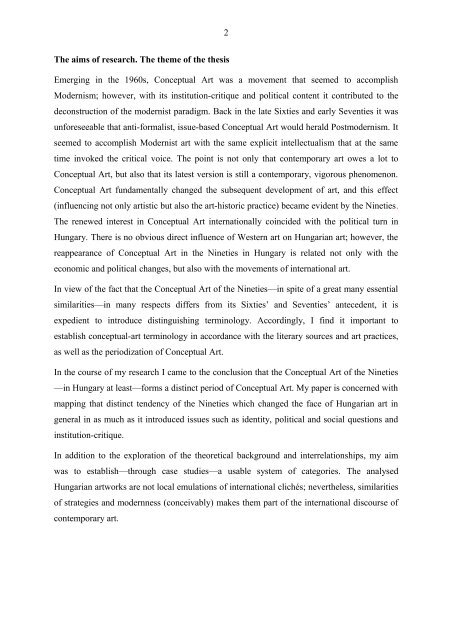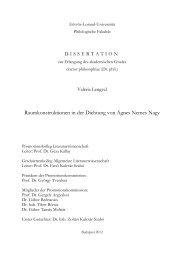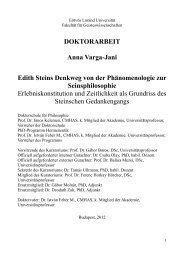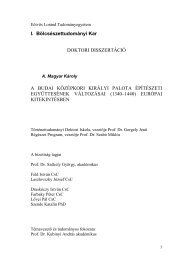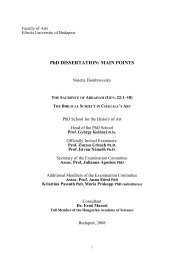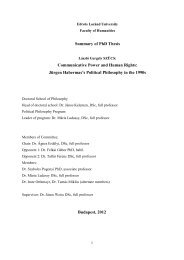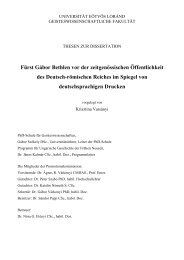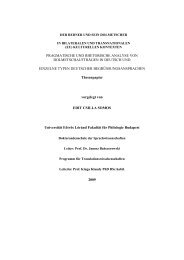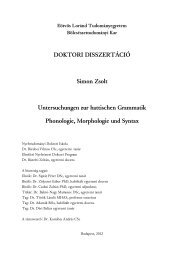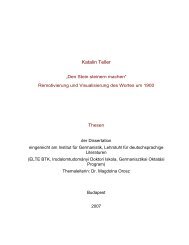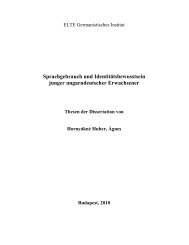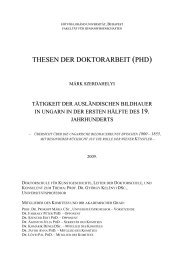eötvös loránd university faculty of humanities - ELTE BTK disszertációk
eötvös loránd university faculty of humanities - ELTE BTK disszertációk
eötvös loránd university faculty of humanities - ELTE BTK disszertációk
You also want an ePaper? Increase the reach of your titles
YUMPU automatically turns print PDFs into web optimized ePapers that Google loves.
The aims <strong>of</strong> research. The theme <strong>of</strong> the thesis<br />
Emerging in the 1960s, Conceptual Art was a movement that seemed to accomplish<br />
Modernism; however, with its institution-critique and political content it contributed to the<br />
deconstruction <strong>of</strong> the modernist paradigm. Back in the late Sixties and early Seventies it was<br />
unforeseeable that anti-formalist, issue-based Conceptual Art would herald Postmodernism. It<br />
seemed to accomplish Modernist art with the same explicit intellectualism that at the same<br />
time invoked the critical voice. The point is not only that contemporary art owes a lot to<br />
Conceptual Art, but also that its latest version is still a contemporary, vigorous phenomenon.<br />
Conceptual Art fundamentally changed the subsequent development <strong>of</strong> art, and this effect<br />
(influencing not only artistic but also the art-historic practice) became evident by the Nineties.<br />
The renewed interest in Conceptual Art internationally coincided with the political turn in<br />
Hungary. There is no obvious direct influence <strong>of</strong> Western art on Hungarian art; however, the<br />
reappearance <strong>of</strong> Conceptual Art in the Nineties in Hungary is related not only with the<br />
economic and political changes, but also with the movements <strong>of</strong> international art.<br />
In view <strong>of</strong> the fact that the Conceptual Art <strong>of</strong> the Nineties—in spite <strong>of</strong> a great many essential<br />
similarities—in many respects differs from its Sixties’ and Seventies’ antecedent, it is<br />
expedient to introduce distinguishing terminology. Accordingly, I find it important to<br />
establish conceptual-art terminology in accordance with the literary sources and art practices,<br />
as well as the periodization <strong>of</strong> Conceptual Art.<br />
In the course <strong>of</strong> my research I came to the conclusion that the Conceptual Art <strong>of</strong> the Nineties<br />
—in Hungary at least—forms a distinct period <strong>of</strong> Conceptual Art. My paper is concerned with<br />
mapping that distinct tendency <strong>of</strong> the Nineties which changed the face <strong>of</strong> Hungarian art in<br />
general in as much as it introduced issues such as identity, political and social questions and<br />
institution-critique.<br />
In addition to the exploration <strong>of</strong> the theoretical background and interrelationships, my aim<br />
was to establish—through case studies—a usable system <strong>of</strong> categories. The analysed<br />
Hungarian artworks are not local emulations <strong>of</strong> international clichés; nevertheless, similarities<br />
<strong>of</strong> strategies and modernness (conceivably) makes them part <strong>of</strong> the international discourse <strong>of</strong><br />
contemporary art.<br />
2


